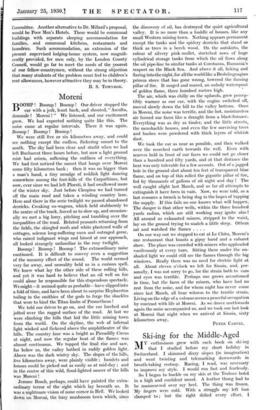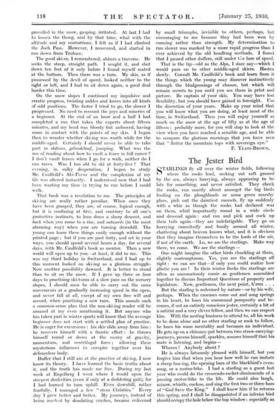Ski-ing for the Middle-Aged
MY enthusiasm grew with each book on ski-ing that I studied before my short holiday in Switzerland. I skimmed dizzy slopes (in imagination) and went twisting and telemarking downwards in breath-taking ecstasy. Racing, I read, was necessary to improve my style. I would run fast and fearlessly. So I began to buckle on my skis at the Trubsee hotel in a high and confident mood. A leather thong had to be manoeuvred over my heel. The thing was frozen. 'My fingers litre cold.. With a struggle my left foot 'clamped - to ; but the right defied every effort. I grovelled in the snow, gasping, irritated. At last I had to loosen the thong, and by that time, what with the altitude and my contortions, I felt as if I had climbed the Joch Pass. However, I recovered, and started to run down from Trubsee.
The good ski-er, I remembered, abhors a traverse. He seeks the steep, straight path. I sought it, and shot down ten feet of it only before I found myself seated at the bottom. Then there was a turn. My skis, as if possessed by the devil of speed, looked neither to the right or left, and I had to sit down again, a good deal harder this time.
On the snow slopes I continued my impulsive and erratic progress, twisting ankles and knees into all kinds of odd positions. The faster I tried to go, the slower I progressed. No need to recount the joys and miseries of a beginner. At the end of an hour and a half I had completed a run that takes the experts about fifteen minutes, and my head was bloody but unbowed, having come in contact with the points of my skis. I began then to wonder whether ski-ing was worth while for the middle-aged. Certainly I should never be able to take part in .slaloms, gelandelauf, jumping. What was the use of reading about how to vault a fence in full career ?
I don't vault fences when I go for a walk, neither do I run races. Was I too old to ski at forty-five ? That evening, in sulky desperation, I began to study Mr. Caulfeild's Ski-Turns and the complexion of my life was altered instantly. I understood now that I had been wasting my time in trying to run before I could walk.
That book was a revelation to me. The principles of ski-ing are really rather peculiar. When once they have been grasped, they are, of course, logical enough, but it is confusing at first, and contrary to all one's protective instincts, to lean down a sharp descent, and back when you come to a rise, and outwards (in the most alarming way) when you are turning downhill. The young can learn these things easily enough without the printed page ; but if you are past forty, and set in your ways, you should spend several hours a day, for several days, with Mr. Caulfeild's book as mentor. Then a new world will open up to you—at least, it did to me. This was my third holiday in Switzerland, and I had up to this moment looked on ski-ing as a glorious struggle.
Now another possibility dawned. It is better to stand than to sit on the snow. If I gave up three or four days to practising ski-turns at a slow pace on the nursery slopes, I should soon be able to carry out the same movements at a gradually increasing speed in the open, and never fall at all, except of my own free will and accord, when practising a new turn. This sounds such a common-sense plan that the non-ski-ing reader will be amazed at my even mentioning it. But anyone who has taken part in winter sports will know that the average beginner does not start with a settled plan of practice.
He is eager for excursions : his skis slide away from him : he recovers himself with a frantic effort : he throws himself round or down at the mercy of gravity, momentum, and centrifugal force ; allowing these mysterious influences to conspire together over his defenceless body.
Duffer that I still am at the practice of ski-ing, I now know its theory. I have learned the basic truths about it, and the truth has made me free. During my last week at Engelberg I went where I would upon the steepest declivities (even if only at a doddering gait), for I had learned to turn uphill. Even downhill, rather fearfully, I managed a few " stein Christics." Every ..day I grew better and better. My journeys, instead of being marked by desolating crashes, bec' anie enlivened by small •triumphs, invisible to others, perhaps, but encouraging to me because they had been won by cunning rather than strength. My determination to run slower was marked by a more rapid progress than I ever achieved by the old headlong methods. I found that I passed other duffers, still under Q.e lure of speed.
That is the tip—old as the Alps, I dare say—which I would pass on to other middle-aged skiers. Hasten slowly. Consult Mr. Caulfeild's book and learn from it the things which the young may discover instinctively through the .bludgeonings of chance, btit which will remain secrets to you until you see them in print and picture. Be captain of your skis. You may have lost flexibility, but you should have gained in foresight. Use the discretion of your years. Make up your mind that you will know what you are doing, at least most of the time, in Switzerland. Then you will enjoy yourself as much on the snow at the age of fifty as at the age of fifteen ; probably more, for you will stop to look at the view when you have reached a sensible age, and be able to compare the glorious mornings that you have seen that " flatter the mountain tops with sovereign eye."
F. YEATS-BROWN.







































 Previous page
Previous page